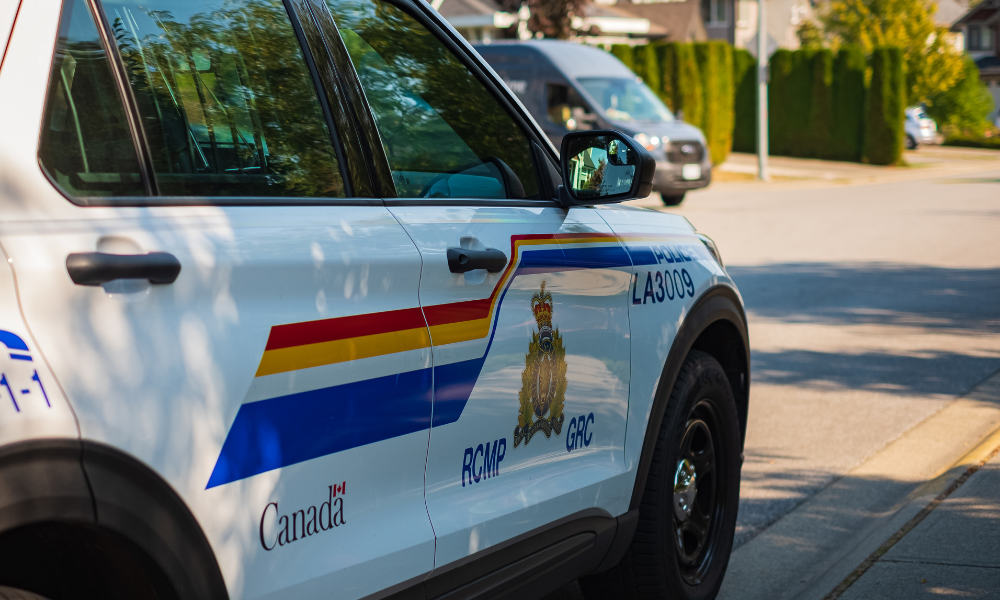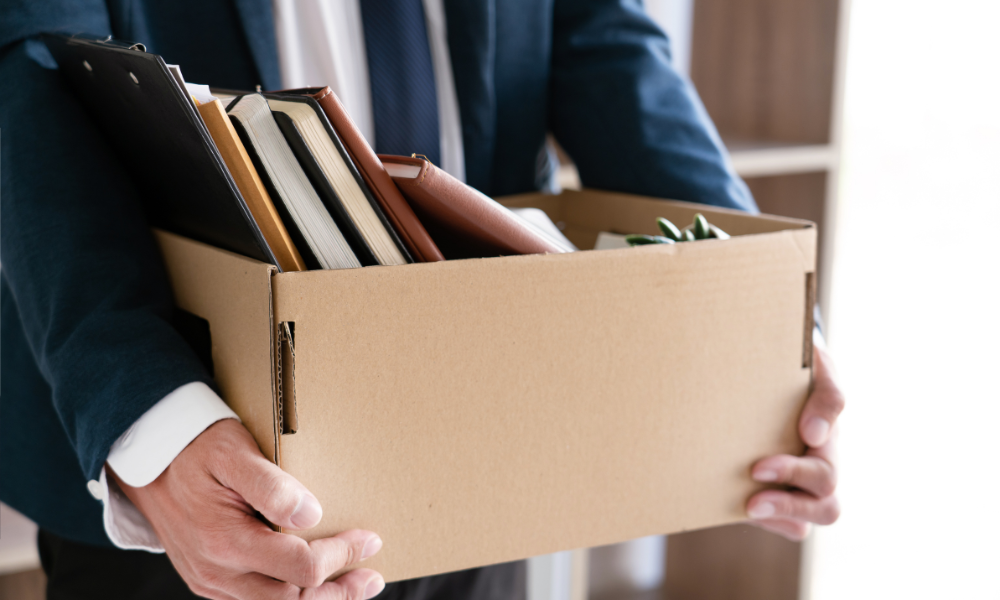The best ear protection for loud machinery helps prevent noise-induced hearing loss among workers. Take your pick from our list of the top earplugs and earmuffs
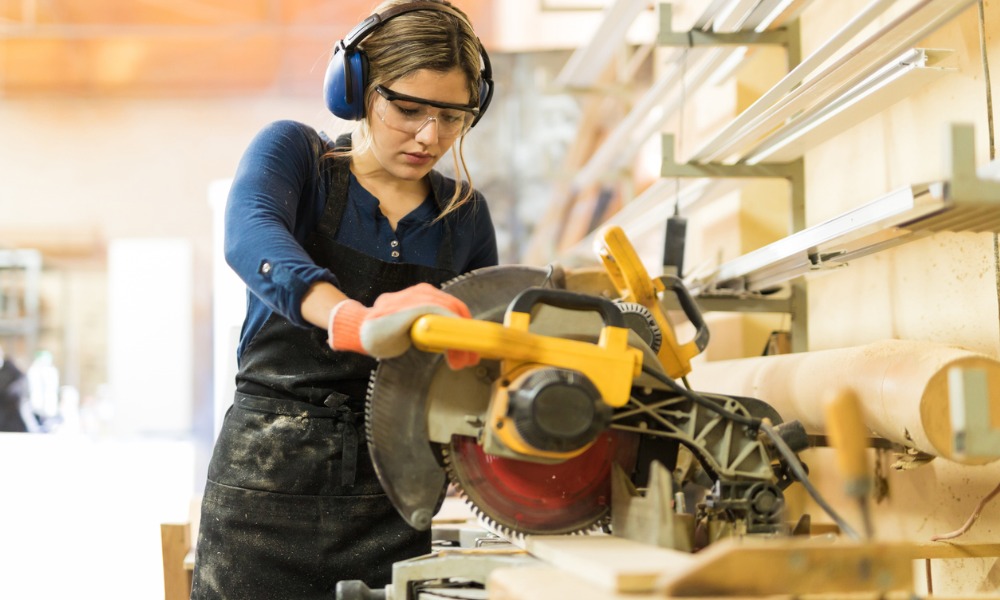
Workers in certain industries – including construction, manufacturing, and aviation – are constantly exposed to excessive noise. This makes them susceptible to irreversible hearing damage, which can adversely impact their quality of life.
For extremely noisy work environments, most jurisdictions require employers to have hearing conservation programs in place. Part of this is providing employees with adequate hearing protection.
In this article, Canadian Occupational Safety lists the best ear protection for loud machinery. We will reveal our top choices for the best earplugs and earmuffs for industrial use. If you’re looking for the most effective hearing protection for your workers, this guide can give you options. Take your pick from our list of top-notch earmuffs and earplugs.
The best ear protection for loud machinery: our top 5 earplugs
Earplugs are designed to fit into the ear canal. They are small and convenient to use but must be kept clean to prevent ear infection. Here are our top picks for the best earplugs for workers operating loud machinery. The list is arranged alphabetically. All prices are current as of July 10, 2024.
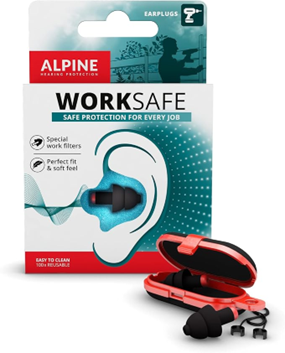
1. Alpine WorkSafe construction earplugs
Key features: Hypoallergenic, silicone-free, noise-cancelling
Price range: $21.35 to $24.99 per pair
Alpine’s WorkSafe earplugs are designed to protect the ears from loud noise from heavy machinery and power tools. The hearing protector is made of a patented silicone-free and hypoallergenic material that follows the contours of the ear canal for a snug fit. The earplugs filter out harmful noise but still enable users to hear external sounds such as machine alarm. Each pair provides NRR protection of 23 decibels (dB).
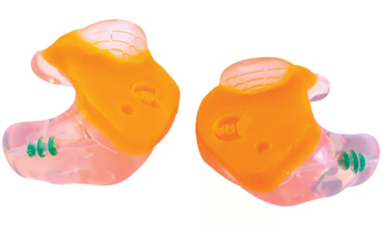
2. Custom Protect Ear dB Blocker Grip earplugs
Key features: Molded handles, supports radio connectivity, protects against dirt and grime
Price range: Undisclosed
The dB Blocker Grip from Custom Protect Ear is a pair of silicone earplugs molded with handles for easy insertion and removal. Apart from blocking out noise, the ear protector shields against dirt and grime. The earplugs also support radio connectivity – there's no need to remove the ear protection to hear incoming radio communication.
Each earpiece is marked with either an “R” or an “L” showing in which ear it should go. It also carries a serial number, so workers can easily identify if the earpiece belongs to them. The dB Blocker Grip is available in vented and non-vented versions.
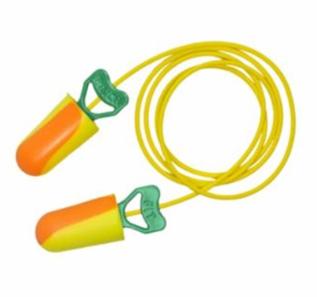
3. Final Fit Safety Pinch Fit biodegradable earplugs
Key features: Plant-based material, biodegradable, oblong
Price range: $67.90 to $87.00 per box
Final Fit Safety’s Pinch Fit is considered the world’s first plant-based earplugs. According to the manufacturer, the hearing protection’s shape is “based on the fact that the ear canal is oblong, not round.” Because of this, the earplugs don’t need to be rolled to fit the ear canal. They also have a smooth and low-pressure design for increased comfort. The ear protector has been tested for NRR 32/SNR 38. Both corded and uncorded versions are available.

4. Hearprotek High Fidelity earplugs
Key features: 26dB attenuation filters, noise-cancelling, three-flanged design
Price range: $20.69 to $32.24 per pair
The High Fidelity earplugs from Hearprotek feature 26dB attenuation filters, making it among the best ear protection for loud machinery. The hearing protector’s noise-cancelling feature blocks out unwanted noise while still allowing the user to hear certain sounds like speech and sirens. The silicone earplugs come in a three-flanged design that fit snugly in the ears. They can also be used in other loud environments, including concerts, air travel, and public transport. Each pair comes with a carrying case and carabiner that clips to bags and belts.

5. SoundGear Phantom hearing protection earplugs
Key features: Bluetooth-enabled, noise-cancelling, compatible with Apple and Android devices
Price range: US$799.50 to US$1,599.00 per pair
SoundGear offers the Phantom product line consisting of Bluetooth-compatible and rechargeable hearing aids and hearing protection devices. The Phantom earplugs block out loud sounds, suppressing noise at 90dB. At the same time, the hearing protector allows users to hear conversations and other environmental sounds. The earplugs come with volume control. They are also compatible with Apple and Android devices. The battery lasts 23 hours if used in one go.
The best ear protection for loud machinery: our top 5 earmuffs
Earmuffs are bulkier than earplugs. These hearing protectors are designed to cover the ears and can be worn with earplugs. Some come with noise-cancelling features, allowing users to hear co-workers’ voices. Here are our choices for the best earmuffs for loud machinery.

1. 3M Peltor X5 earmuffs
Key features: Dual-molded cups, tilt pivot points, comes in three designs
Price range: $48.15 to $52.97
The 3M Peltor X5 earmuffs have an attenuation rating of 31dB NRR/SNR. The hearing protector comes with dual-molded cups made of ABS and polyurethane. The earcups have tilt pivot points and slow-recovery foam cushioning for enhanced comfort. The wire headband is electrically insulated. The earmuffs are available in behind-the-head, hard hat-attached, and over-the-head designs.
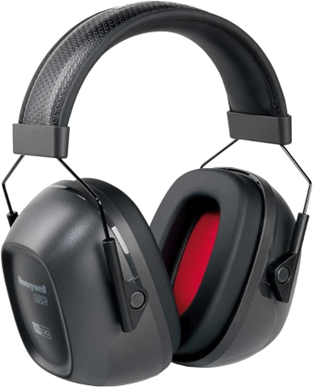
2. Honeywell VeriShield Smart Hearing Solution earmuffs
Key features: Analyzes noise-exposure data, noise-limit notification, fit-testing function
Price range: $85.64 to $106.28
Honeywell’s VeriShield Smart Hearing Solution earmuffs integrate a cloud-based software that tracks and analyzes sound in real time. This feature helps protect workers against noise-induced hearing loss (NIHL). Employers can assess noise exposure data on mobile devices through the Honeywell VeriShield app. The software can also generate records automatically to help companies meet compliance regulations and reduce timely administrative procedures.
Among the best ear protection against loud machinery, VeriShield notifies workers when they are nearing or surpassing their daily noise limits through visual and audible alerts. It also has a fit-testing feature that notifies the user or safety manager if the earmuffs are not properly fitted or worn.
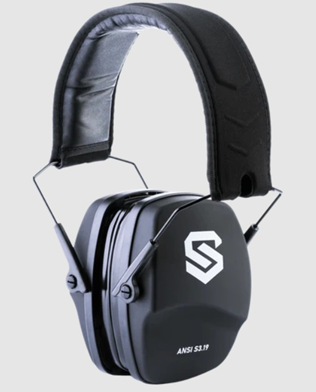
3. Shellshock Protection EXO Passive Earmuffs
Key features: Gel-padded cuffs, adjustable padded metal frame, suits rifle shooting
Price: US$55.00
The EXO Passive Earmuffs from Shellshock Protection are ANSI-rated for 28dB SNR and 23dB NRR hearing protection. This means that the hearing protector is effective against loud noise from heavy machinery, pistols, and rifle calibers.
The earmuffs come with gel-padded cups for improved comfort and better sealing even when wearing the best safety glasses. The hearing protector also has an adjustable padded metal frame. A set includes a drop-proof carrying case.
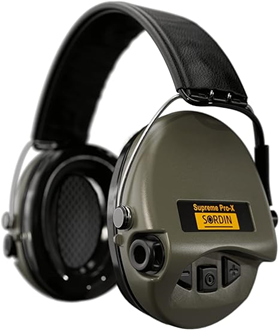
4. Sordin Supreme Pro-X earmuffs
Key features: SordinHEAR2 sound system, IP67 water resistance, suits hunting and special forces
Price range: $224.99 to $334.99
The Sordin Supreme Pro-X earmuffs block out loud noises while amplifying low sounds, allowing users to hear conversations and warning sounds. The hearing protector uses the SordinHEAR2 sound system that provides excellent sound quality in four audio profiles. It is designed for hunting, special forces, and work environments with loud machinery. The earmuffs have compact earcups with sealing rings made of PVC foam. The ear protection also passed IP67-testing for water resistance.
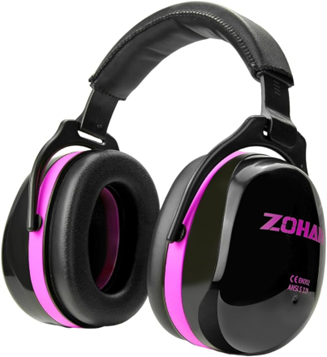
5. Zohan 012 Hearing Protection earmuffs
Key features: Adjustable metal frame, 360-degree rotating cups, double acoustic foam, leather ear cushions
Price: $26.99
The Zohan 012 Hearing Protection earmuffs come with an adjustable telescopic metal frame and 360-degree rotating earcups. These features allow the hearing protector to fit different head sizes comfortably. The earmuffs provide 28dB NRR protection, making the product among the best ear protection for loud machinery. The dual-molded cups are made of ABS and have double acoustic foam that reduces noise levels. The leather ear cushions provide all-day comfort.
Learn more about the personal protective equipment requirements, including hearing protection, in your industry in this essential guide to personal safety equipment.
What are the different types of hearing protection?
The Canadian Centre for Occupational Health and Safety (CCOHS) lists two general categories of hearing protection:
1. Earplugs
This type of ear protection is designed to be inserted into the ear canal. Both disposable and reusable versions are available. Earplugs come in various constructions, including:
- pre-molded
- moldable
- rolldown foam
- push-to-fit
- custom molded
Semi-insert earplugs are also available. These consist of two earplugs held over the ends of the ear canal by a rigid headband.
2. Earmuffs
Earmuffs consist of two sound-attenuating cups often with soft ear cushions that cover the ear, held together by a headband. They are bulkier than earplugs and provide more coverage. Some versions, however, are not comfortable to wear in hot work environments.
Earplugs vs. earmuffs: which is better?
Earmuffs are often viewed as offering better ear protection compared to earplugs because of their size and design, but this is not necessarily true. The choice of the best ear protection against loud machinery depends on a range of factors, including personal preference.
Earplugs are more comfortable to wear in hot or damp work environments. But to be effective, they must be inserted properly. Users must also ensure that the earplugs are clean to prevent ear infection.
Earmuffs cover the entire ear, that’s why they are typically seen as providing better hearing protection. They are more durable than earplugs but are also more expensive. The main drawback of this type of ear protection is that it is less comfortable to wear in hot and damp worksites.
Earplugs and earmuffs can be worn together to provide the best ear protection for loud machinery.
Here’s a summary of the pros and cons of earplugs and earmuffs, according to the CCOHS.
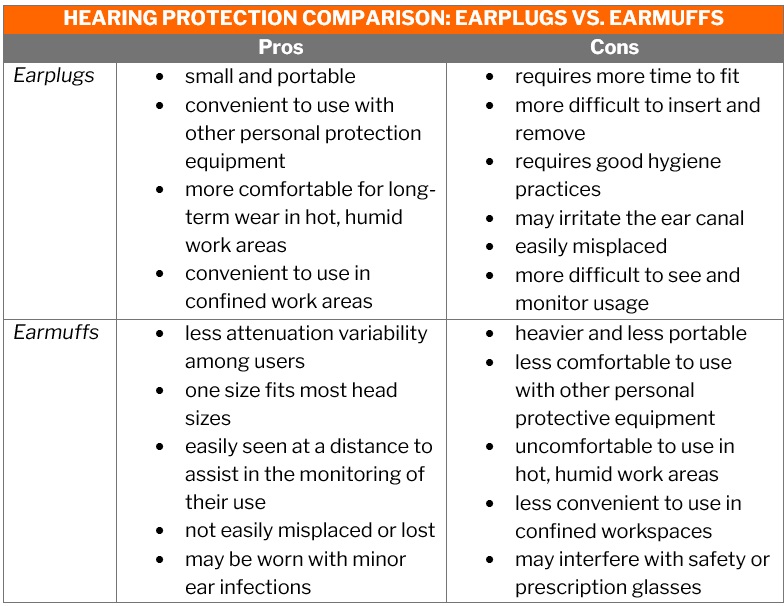
If loud noise poses a big risk to your business, here are some tips on how to choose the right hearing protection for your employees.
What is the highest rated ear protection?
The noise reduction rating, also called NRR, shows the level of noise that hearing protectors block out in normal working conditions. This rating system is used to accurately determine a worker’s level of exposure when wearing ear protection. NRR applies only to earplugs and earmuffs.
The highest NRR for earplugs is 33dB, while the highest for earmuffs is 31dB. Wearing both types of hearing protection can deliver an NRR of 36dB. For context, rustling leaves, soft music, and whispering have a noise level of 30dB. Normal conversation and background deliver 60dB on average. Heavy traffic, power lawn mowers, and a noisy restaurant produce between 80dB and 89dB. Noise levels above 85dB are considered harmful to a person’s hearing.
When is hearing protection required?
All Canadian jurisdictions allow a steady noise limit – also called the criterion level – of 85dBA for a full eight-hour shift. The maximum allowable limit for federal organizations is 87dBA.
If the employees are exposed to noise levels exceeding 85dBA, all provinces and territories require employers to:
- provide appropriate hearing protectors
- train employees in the proper use of ear protection
- implement audio-metric testing
All jurisdictions also don’t allow unprotected exposure to sound levels exceeding 90dBA.
You can find more information about the noise exposure limits in your jurisdiction by checking the corresponding legislation, which COS has compiled below. You can also contact the occupational and health safety agency in your area.
|
NOISE EXPOSURE LIMITS BY PROVINCE AND TERRITORY |
|
|
Jurisdiction |
Legislation |
|
Occupational Health and Safety Code, 2023 Part 16 |
|
|
Worker's Compensation Act Occupational Health and Safety Regulations (BC Reg 296/97 as amended) Section 7.2 [B.C. Reg. 382/2004, s.1] |
|
|
Workplace Safety and Health Act [R.S.M. 1987, c. W210] Workplace Safety and Health Regulation (Man. Reg. 217/2006) Part 12 |
|
|
Occupational Health and Safety Act |
|
|
Occupational Health and Safety Act |
|
|
Safety Act |
|
|
Workplace Health and Safety Regulations |
|
|
Safety Act Occupational Health and Safety Regulations, R-003-2016 Part 8 Noise Control and Hearing Conservation |
|
|
Occupational Health and Safety Act [R.S.O. 1990, c.1] Noise (O. Reg. 381/15) |
|
|
Occupational Health and Safety Act Occupational Health and Safety Act General Regulations (E.C. 180/87) Part 8, Section 8.3 |
|
|
Act Respecting Occupational Health and Safety [R.S.Q., c.2.1] Regulation respecting Occupational Health and Safety (O.C.885-2001) Division XV, Sections 130-141.5 |
|
|
Saskatchewan Employment Act, S-15.1 |
|
|
Occupational Health and Safety Act |
|
Get more news and information about the best hearing protection for your industry by visiting our Product Resources page. Be sure to bookmark this page for the latest industry updates.
What’s your pick for the best ear protection for loud machinery? Let us know in the comments.
Related Articles:
The best safety glasses for construction workers
The most comfortable work boots for construction sites
The best hard hats to recommend to your construction team
The best work gloves for heavy-duty protection
The best hearing protection for construction workers
The best welding helmets for industrial protection
Roof safety equipment: an essential guide for roofers in Canada
The 10 best respirators for painting projects
The best welding respirators for heavy-duty tasks



